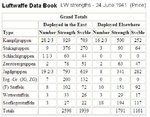Juha, my mistake. Transport Command doesn't seem to be included at all, I believe the figures I gave for transports are troop carriers of 38 Group.
The figures show 204 Dakota delivered to the RAF in the year to 3 September 1943, and another 792 in the year to Sept 1944. I have no idea how many were with squadrons, though.
As to reserve aircraft in squadrons, it's true that 1,824 Spitfires in squadrons means less than that would be capable of flying at any one time, but then again that's true of the Luftwaffe figures as well.
But the point I was trying to make about reserves is the RAF had additional aircraft in storage, over and above the aircraft with squadrons.
Here are the figures for April 1945. The first figure is the number of aircraft in front line squadrons in the UK and Northern Europe, the second is the total number of aircraft on hand in those areas:
SE Fighters
Spitfire - 804 (2,557 (VIII, IX, XIV and XVI only)
Typhoon - 332 (1,234)
Tempest - 131 (468 )
Mustang - 302 (782 (III IV only))
As you can see, the RAF typically had several times as many aircraft "on hand", compared to the "front line squadron" strength.
The figures show 204 Dakota delivered to the RAF in the year to 3 September 1943, and another 792 in the year to Sept 1944. I have no idea how many were with squadrons, though.
As to reserve aircraft in squadrons, it's true that 1,824 Spitfires in squadrons means less than that would be capable of flying at any one time, but then again that's true of the Luftwaffe figures as well.
But the point I was trying to make about reserves is the RAF had additional aircraft in storage, over and above the aircraft with squadrons.
Here are the figures for April 1945. The first figure is the number of aircraft in front line squadrons in the UK and Northern Europe, the second is the total number of aircraft on hand in those areas:
SE Fighters
Spitfire - 804 (2,557 (VIII, IX, XIV and XVI only)
Typhoon - 332 (1,234)
Tempest - 131 (468 )
Mustang - 302 (782 (III IV only))
As you can see, the RAF typically had several times as many aircraft "on hand", compared to the "front line squadron" strength.


